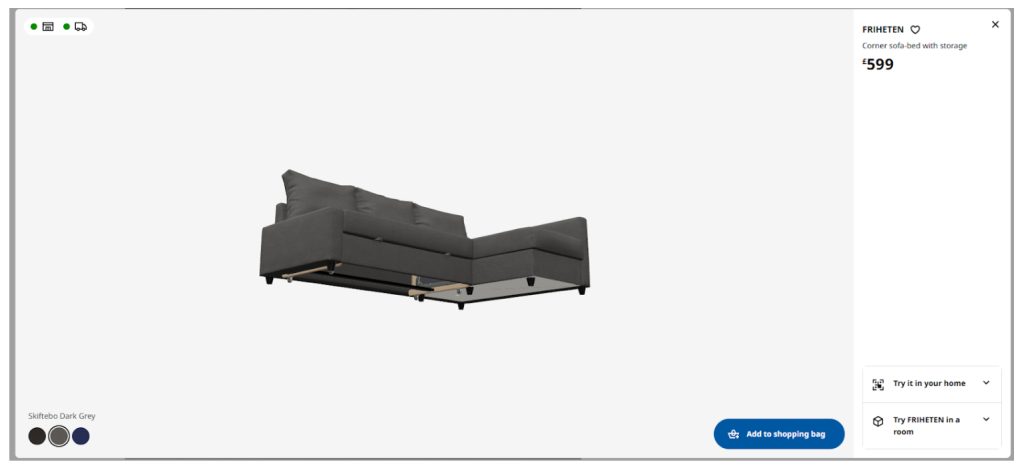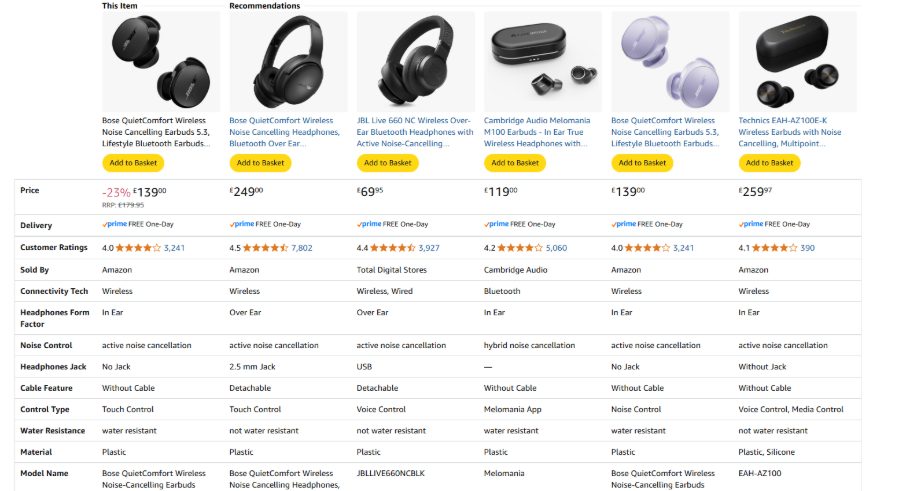When it comes to eCommerce returns, businesses often find themselves between a rock and a hard place.
Online shoppers expect cost- and hassle-free returns, and generous return policies boost sales. However, effective returns require mature processes, which means additional overhead. And an overly liberal policy may invite abuse and erode margins even further.
In this article, we share best practices for managing customer returns, offer tips on reducing them and their financial impact, and demonstrate how Doofinder can assist. We also explain the main reasons for returns and how much it costs eCommerce businesses.
Why Do Customers Return Products?
Based on the recent UK study by Signifyd, the top return causes include:
- Defective or damaged product (in manufacturing & shipping) — 56%
- Wrong size and fit — 45%
- Product not as described (pictures, descriptions) — 32%
- Product no longer needed — 17%
- Found a better price — 14%
- Bracketing (buying several different sizes or versions of a product and returning all but one) — 10%
- Wardrobing (wearing or using a product once or twice before returning it) — 4%
Other reasons why people return items purchased online are:
- Buyer’s remorse
- Poor quality product
- Wrong product ordered/sent
- Shipping and delivery problems (such as delays)
- Poor customer service
How Much Do Returns Cost eCommerce Brands?
There’s no consensus on how much exactly returns cost eCommerce stores.
According to Statista, returns cost US retailers $817 billion in 2022. A quarter of these are estimated to be online retail returns, so over $200 billion.
This is more than in other sources. For example, Signifyd estimates global losses due to returns in 2023 at $700 billion, so less than the Statista source for the US alone.
One reason for the discrepancies is how each source defines “loss.” Many sources cite the value of the returned items as the cost, which is around $890 globally. This doesn’t give a full picture, though, because it ignores:
- Loss of value (only about half of the returned goods can be resold for the full price)
- Return shipping costs
- Sorting and reshelving costs
- Infrastructure overheads
- Reselling costs
The processing costs range from 20% to 65% of an item’s original value, and are particularly painful for small merchants selling low-value items.
How to Reduce Customer Returns: 7 Ways
Online returns are inevitable. You can, however, decrease the return rate. Here are seven tried-and-tested strategies to reduce the number of returns on online purchases.
1. Use Quizzes to Help Customers Choose the Right Product
Product quizzes, such as those you can build in Doofinder, reduce returns by steering customers to the right items.
By asking them a sequence of branched questions, they gradually reduce their options to goods that tick their boxes. The result: they’re less likely to be dissatisfied once the goods arrive.

2. Provide Relevant Product Recommendations
Doofinder’s personalized recommendations — fuelled by past search, behavior, and purchase data — also reduce returns. When customers choose a product that meets their true needs or desires, they’re less likely to feel buyer’s remorse.
There are two ways to embed such recommendations in the shopping experience:
- Carousels across the website promote related products, driving upsells and cross-sells.
- AI-powered search surfacing tailored results.

3. Package Goods Securely & Use Reliable Shipping Partners
Protective packaging can reduce the likelihood of returns. Think foam inserts, molded pulp, padded envelopes. Anything that stops items from getting damaged in transit.
A case in point: Pregis reports one client reduced the item damage rate from 0.6 to 0.2% by switching from void-fill pillows to hybrid cushioning. This reduced their losses resulting from shipping damage by 65%.
You can also reduce the risk of item damage by working with a reliable shipping company.
A reputable shipping partner is also less likely to lose the parcel or deliver it too late.
4. Invest in Quality Visuals
Online customers cannot touch products, but you can bridge the gap with high-quality imagery that accurately shows what the product looks like.
This includes:
- Multi-angle shots, zoom-ins, and real-life shots.
- Spinning 360-degree views.
- Explainer and demo videos.

Pro tip: Don’t over-Photoshop the images. Realistic visuals set realistic expectations, reducing the risk of disappointment when the item arrives.
5. Provide Dynamic Sizing Charts & Virtual Try-Ons
Merchants embedding AR/VR in the store report a 25% decrease in returns, and virtual try-ons can reduce them by up to 20%.
Considering that the wrong size or fit is one of the top return causes, the drop is logical. If customers can see if the product fits them and what they look like wearing it, they’re less likely to return it for exchange or buy multiple items to try on at home.

If implementing these solutions isn’t feasible, consider adding dynamic sizing charts to your pages, which requires no technical skills on platforms like Shopify. In this way, your customers will always see the right chart, no matter which product they’re viewing.
3D product visualization can help you reduce not only clothes returns. For example, furniture retailers, like Ikea, use it to show customers what the product will look like in real life. That’s how Home Depot managed to reduce its returns by 35%.

6. Collect and Display Reviews
In addition to professional photos, enhance your product pages with real-life user-generated images.
Many online retailers collect and display them, along with customer reviews, to drive conversions. However, they can also reduce returns by helping buyers choose the most suitable products and reinforcing the conviction that they’re making the right choice.

Pro tip: Include customer ratings and reviews in confirmation emails to soothe buyers’ remorse.
7. Publish Bullet-Proof Specs & Comparison Tables
Detailed specs help eCommerce customers choose the right item, reducing the risk that the product won’t meet their expectations once it arrives.

This applies not only to complex products, such as electronics or automobiles. Even “simple” goods — food, toiletries, cosmetics — benefit from clear specs.
What is eCommerce Return Management?
eCommerce return management, also known as reverse logistics, is the systematic handling of products that customers send back to an online store, from the moment they initiate the return until they receive a refund and beyond.
What is the eCommerce Return Process?
The eCommerce process consists of 7 steps:
- The customer initiates the process.
- The retailer reviews the return request.
- The retailer generates a return label.
- The customer ships the product back.
- The retailer inspects returned items.
- The retailer processes a refund or exchange.
- The retailer confirms that the refund has been processed and asks for feedback.
The process involves customer support, logistics, and inventory management — labor that piles on retailers’ costs.
However, an efficient and effective returns process keeps customers loyal and drives repeat custom: Around 67% of US shoppers won’t purchase from a retailer again after a bad returns experience.
5 eCommerce Returns Best Practices
To help you handle eCommerce returns effectively, we’ve compiled a list of five best practices.
1. Create a Comprehensive Return Policy
A comprehensive but concise eCommerce return policy earns customers’ trust, sets expectations, and guards your business from abuse — and legal issues.
When creating your policy, you have a few challenging questions to answer:
- What’s returnable? Perishables, personalised goods, or hygiene-sensitive products might be difficult to resell.
- What’s the return window? A 30-day return window can increase conversions by 57%, Shopify has found. However, longer return windows can stress your cash flow and inventory management systems.
- Who pays for return shipping? 76% of customers consider free return shipping when shopping, but it isn’t viable for all items. The break-even point is said to be around $50, but this depends on individual circumstances, so do your own maths.
- What’s the outcome? Refunds are easier to process than exchanges, but customers may choose to shop with another retailer for their next purchase; store credit is a possible alternative.
- What’s the best return model? Buy-Online-Return-In-Store (BORIS) comes with lower overheads, but the model works only if you have actual physical stores. If you don’t and can’t partner with other retailers to use their infrastructure, the only option is shipping back to the warehouse.
Designing your returns policy is a balancing act: Make it too strict, and you will scare buyers off. Make it too liberal, and you risk being exploited by dishonest buyers and losing profits.
2. Make your Product Return Process Sustainable
Product return sustainability isn’t a nice-to-have. It’s a must.
You’ve heard the stats! 74% of consumers who took part in the RetailX Sustainability 2023 survey expect greener retailers. And the environmental footprint of returns is enormous. In the US, reverse logistics generate 5.8 billion pounds of landfill waste and 16 million metric tonnes of CO₂ emissions annually, according to Optoro 2020 data.
You can make your return process more sustainable by:
- Minimizing packaging waste: Ditch prepackaged free-return labels, use appropriate packaging, employ reusable packaging solutions, like cages with lids, opt for recyclable packing materials made of biodegradable plastics, single-material packaging, and systematically collect materials for recycling at every stage.
- Promoting re-use, repair, and resale of returned items: Repair or refurbish items for resale when possible, optimize inventory flow to quickly grade and restock products for resale, and channel items for secondary markets (discount outlets, own-brand eBay stores, etc). Consider “take-back” schemes where customers can return products for reuse or recycling, like Decathlon’s “No tent left behind 2025” scheme.

- Optimizing logistics and transportation: Minimize unnecessary transportation, partner with efficient carriers, consolidate returns to reduce the number of individual trips, and collaborate with local parties to reduce long-distance shipping.
- Educating and incentivizing customers: Discourage over-ordering, provide incentives for eco-friendly choices, or reminders to carefully unpack items to preserve their original packaging, and communicate sustainability initiatives to temper irresponsible purchasing behavior.
3. Keep Customers Informed About Return Status
Proactive return status updates fuel customer trust, satisfaction, and repeat buys.
Here are a few tips for keeping customers informed about their returns:
- Use automation to send updates once customers have shipped the item back; confirm receipt of the returned order and provide an estimated refund time.
- Provide a tracking number from the shipping carrier so they can monitor the shipping status themselves.
- Make return status information easy for customers to find and access across multiple touchpoints, including return portals, emails, SMS, FAQ pages, chat widgets, and help centers.
While automation aids efficiency, live customer service is essential for more complex inquiries. Providing helpline information and responsive support for troubleshooting can prevent returns for issues that could be resolved by phone, email or chat.
4. Process Refunds Promptly
Processing refunds in a timely manner is vital for customer satisfaction and trust.
Consider this: the moment a customer returns an item because it doesn’t meet their needs, they’re already hunting for an alternative.
But they need the money to make the purchase, so a delayed refund can be truly frustrating, and can sway them away from making subsequent purchases on your website.
5. Collect Customer Feedback About Return Experience
There’s one more step in the return process after the refund: capture customer feedback about their experience while you still have their attention.
Their insights, combined with other return data such as reasons for return, will help you improve your processes and provide an even better online shopping experience, ultimately driving customer satisfaction and loyalty.
How to Reduce the Impact of eCommerce Returns
You cannot avoid returns on online orders entirely – that’s the nature of the eCommerce
Protect Your eCommerce Business Against Return Fraud
Return fraud dents profits: The fraud return rate in 2023 was 13.7% and fraudulent claims cost businesses $103 billion, according to the 2024 Appris Consumer Returns in the Retail Industry Report.
Common return scams include returning fake items, claiming a product never arrived, even though it did, returning an empty box, or a box filled with junk. Bracketing and wardrobing, although they often don’t violate policies, cause damage, too.
How do you curtail return fraud?
Here are a few ideas:
- Use tracking on all shipments to provide proof of delivery and deter claims of non-delivery.
- Inspect items during packing to ensure they aren’t damaged.
- Issue refunds only upon receiving (and inspecting) returned goods.
- Utilize evidence kits (photos, weight-on-scale videos, etc.) to prevent disputes over empty boxes and damaged items.
- Use “evidence kit” to win chargebacks on empty-box disputes—none of the mainstream guides even mention it.
- Employ AI fraud detection tools to identify suspicious patterns.
- Monitor customer behaviors and ban serial returns, as seen with Boozt in Sweden or ASOS in the UK.
1. Promote Exchanges Over Returns
Steering customers toward exchanges instead of returns cushions the financial hit.
Yes, you still incur the processing, shipping, or reshelving costs, but you keep the revenue from the sale.
To encourage customers to exchange unwanted goods,
- Make exchange the default option to leverage the primacy effect
- Sweeten the deal with a voucher. Reebok adds a 10% gift card to every exchanged item to tilt customers away from refunds
- Ship exchange orders instantly, before receiving the goods (to trusted customers only)
- Make personalized product recommendations based on the return reason
- Offer longer windows for exchanges than for returns
2. Offer “Keep-it” Refunds on Low-Value Items
A “keep-it” refund is when you issue the refund without asking the customer to return the item.
This is common practice for items whose resale value is lower than the return shipping cost. By paying postage, you lose twice.
3. Introduce a Tiered Approach to Free Returns
As mentioned above, offering free return shipping isn’t always viable. If the item is of low value or the return cost is particularly high, and if you were to cover it, your business would be incurring a loss.
In such circumstances, use a tiered system: offer free returns for items only above certain value, and spell it out plainly in your policy. Yes, this will probably put off some customers, but it will protect your business from incurring losses.
4. Automate the Return Process
Automating your return process with returns management software like Happy Returns or AfterShip reduces costs along the line because it.
- Requires less live agent involvement, cutting labor costs and errors.
- Speeds up the process, resulting in higher customer satisfaction, and products can be put up for resale in a shorter timeframe.
- Provides you with up-to-date status updates, enabling more efficient inventory management.
- Allows you to retain up to 50% of the revenue by incentivizing exchanges over refunds.
Alternatively, you can outsource the whole process to a third-party reverse-logistics company and let them handle returns on your behalf.
Conclusion
eCommerce returns are inevitable: if customers can’t touch the product, try it on or out, there’s always a risk they won’t be satisfied with their purchase and will want to return it.
Because returns are costly, minimising them is essential. You can do it by providing detailed product descriptions, quality visuals, virtual try-ons, and 3D visualizations to set realistic expectations and help the customer choose the right product.
You can guide customers to products that they will want to keep with Doofinder product quizzes, personalized recommendations, and search results. Try Doofinder for free for 30 days!
FAQ about eCommerce Returns
An eCommerce return is any delivered order that the customer sends back, triggering reverse logistics:
The shopper initiates the return, prints a label, and drops the parcel at a designated hub or store. The item then travels back through carriers to a warehouse or 3PL company for inspection.
Depending on its condition, it may be restocked, refurbished, liquidated, or recycled, and the customer receives a refund, exchange, or store credit.
Every touchpoint — shipping, labor, data entry, and resale markdown — adds cost, so a disciplined returns strategy is critical to eCommerce profit.
In the US, the average eCommerce return rate in 2024 was 16.9% based on data gathered by NRF and Happy Returns from 200+ retailers. Globally, Capital One Shopping estimates it to be around 24.5% based on card network data.
The return rates also depend on the product category: apparel or footwear tend to have a high return rate, while books, media, or electronics considerably lower.
In contrast, the average rate for in-store purchases is around 8.7%.
A good customer return rate depends on your product category and season. As shown above, clothes and shoes have the highest return rates, and you can expect higher return rates in the post-holiday “returns week.”
The rule of thumb is that a return rate of under 10% is excellent, 15-20% — average, and 20-30% — high.







